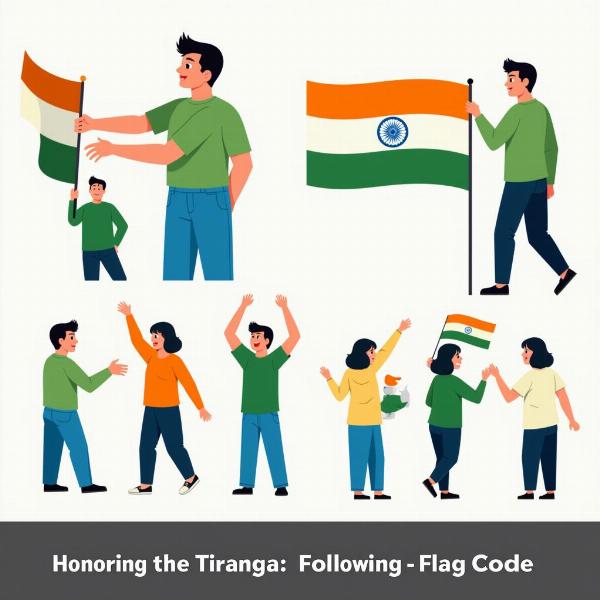The Indian flag, known as the “Tiranga” (meaning tricolour in Hindi), is more than just a piece of cloth; it’s a powerful symbol of national pride, unity, and the rich history of India. Understanding the “tricolour flag meaning in Hindi” goes beyond a simple translation; it delves into the cultural and historical significance embedded within each colour and the Ashoka Chakra at its centre. This article will explore the symbolism of the Indian flag, explaining the meaning of each element and its importance in the Indian context.
Decoding the Saffron, White, and Green: Tricolour Flag Meaning in Hindi
The Indian tricolour is horizontally divided into three equal parts: saffron at the top, white in the middle, and green at the bottom. Each colour holds a profound meaning, resonating with the values and aspirations of the nation.
Saffron, or kesari, represents courage, sacrifice, and renunciation. It is a colour associated with spirituality and selfless service to the nation. White, the colour of peace and honesty, signifies purity, knowledge, and the path of righteousness. Green embodies faith, fertility, and prosperity, symbolizing life, growth, and the land of India.
The Ashoka Chakra: More Than Just a Wheel
At the centre of the white band lies the navy blue Ashoka Chakra, a 24-spoke wheel adapted from the Lion Capital of Ashoka at Sarnath. This chakra represents dharma, the moral law, and the cycle of life. The 24 spokes symbolize the 24 hours of the day, representing progress and forward movement. The Ashoka Chakra connects India’s rich past with its progressive present, highlighting the timeless principles that guide the nation.
Why is the Tricolour Flag Meaning in Hindi Important?
Understanding the “tricolour flag meaning in Hindi” allows us to connect with the essence of Indian identity. It fosters a sense of patriotism and respect for the sacrifices made for the nation’s freedom. It’s a reminder of the values that bind us together as Indians, regardless of our diverse backgrounds. The flag is a symbol of unity, reminding us of our shared heritage and the continuous pursuit of progress.
How does the Tricolour Reflect Indian Culture?
The Indian flag reflects the diverse cultural tapestry of India through its colours and symbolism. The saffron reflects the spiritual and philosophical traditions, while the white emphasizes the importance of peace and harmony. The green represents the land’s fertility and the prosperity of its people. The Ashoka Chakra, borrowed from ancient Indian history, signifies the nation’s commitment to righteousness and progress.
What is the Protocol for Displaying the Indian Flag?
The Flag Code of India, 2002, outlines the proper way to display and handle the Indian flag. It dictates the appropriate occasions for hoisting the flag and the manner in which it should be treated. Respecting the flag is considered a mark of respect for the nation and its values.
 Respecting the Indian Flag Protocol
Respecting the Indian Flag Protocol
Conclusion: The Tiranga – A Symbol of Hope and Pride
The “tricolour flag meaning in Hindi” is a testament to India’s rich history, cultural diversity, and the values it upholds. Understanding the symbolism of the Tiranga deepens our appreciation for the nation’s journey and inspires us to contribute to its continued growth and prosperity. The flag stands tall as a beacon of hope, unity, and progress, reminding us of the strength and resilience of the Indian spirit.
FAQ:
- What does the saffron colour on the Indian flag represent? Saffron signifies courage, sacrifice, and renunciation.
- What is the significance of the Ashoka Chakra? It represents dharma, the moral law, and the cycle of life, signifying progress and forward movement.
- Why is the Indian flag called the Tiranga? Tiranga literally means tricolour in Hindi, referring to the three colour bands.
- What does the white colour on the Indian flag symbolize? White represents peace, honesty, purity, knowledge, and the path of righteousness.
- What does the green colour on the Indian flag signify? Green embodies faith, fertility, prosperity, life, growth, and the land of India.
- Where can I find more information about the Indian flag? The Flag Code of India, 2002, outlines the rules and regulations regarding the Indian flag.
- What is the significance of understanding the tricolour flag meaning in Hindi? It helps connect with Indian identity, fosters patriotism, and promotes respect for the nation and its values.
Meaning-Hindi.in is your trusted partner for all your Hindi translation needs. We offer a comprehensive range of translation services, from business and legal documents to technical manuals and website localization. Our team of expert Hindi linguists ensures accurate and culturally sensitive translations, catering to a diverse clientele. Whether you need document translation, website localization, or specialized Hindi translation services, Meaning-Hindi.in is your one-stop solution. Contact us today at [email protected] or call us at +91 11-4502-7584 to discuss your translation requirements.